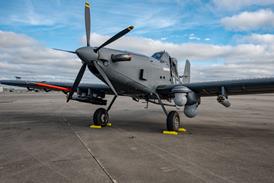David Learmount/LONDON
ROLLS-ROYCE HAS introduced modifications and additional inspection procedures to the RB.211-524H turbofan following an in-flight incident in which a core fairing just aft of the combustion chamber burned through.
A UK Air Accident Investigation Branch (AAIB) report of an incident involving a British Airways Boeing 747-400 just after take-off from Buenos Aires, Argentina, on 10 November, 1994, reveals that the crew shut down the No 4 engine after "a series of loud bangs".
The exhaust-gas temperature had climbed considerably and followed an engine fire warning. The aircraft landed safely.
Examination shows that "...the engine inner casing had burnt through in the region of the trailing edge of the first-stage nozzle guide vanes and the tip seal of the high-pressure turbine".
This had initially allowed combustion gases to escape into the cooling-air cavity before burning through the outer casing of the engine core, says the report. Resulting debris also caused turbine damage.
The cause, it says, was that "a section of the meter panel at the upstream end of the combustion liner had become displaced" because of cracking, causing partial disengagement of some fuel spray nozzles and changing the hot-gas flow path.
The manufacturer has advised borescope inspection of the combustion-chamber heat-shield/ meter panel at all routine inspections, and at any time that "...an excessive shift in the turbine-gas-temperature trend is detected".
Rolls-Royce adds that a "materials change to the combustion chamber lining" is being introduced. BA's engineering department says that it is introducing the change as each engine comes up for its major service.
The new section is made from C 236 in place of the existing Nimonic 75 material, and its different geometry is calculated to be more resistant to cracking.
A Madrid, Spain-based Oasis International Airlines Airbus A310-300 crew shut down the aircraft's No 1 Pratt & Whitney PW4152 engine 20min after take-off from Glasgow Airport, Scotland, bound for the Canary Islands on a charter flight. The aircraft was returned safely to Glasgow.
The AAIB is investigating the problem, which is believed to have originated in the high-pressure fuel system.
Source: Flight International























